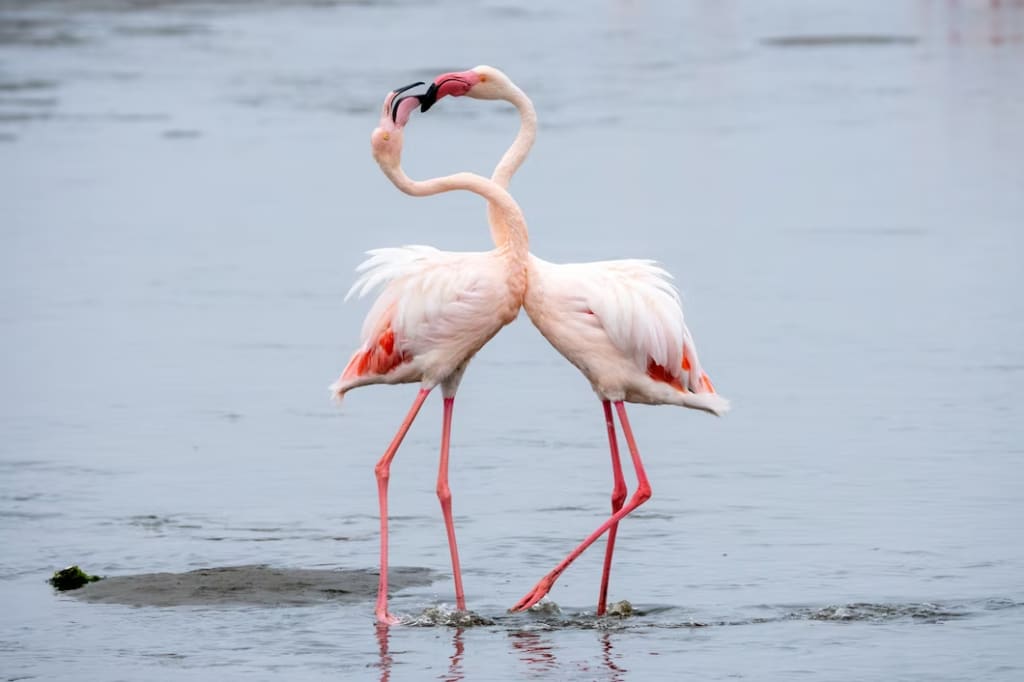
Flamingos, also known as flamingoes, are a type of wading bird that is famous for its striking pink or orange plumage and its long, spindly legs. They are found in various parts of the world, including Africa, Asia, the Americas, and Europe, and are known for their unique adaptations that allow them to survive in some of the harshest environments on the planet. In this article, we will explore the fascinating world of flamingos, examining their anatomy, behavior, habitat, diet, and conservation status.
Anatomy
Flamingos are large, elegant birds that stand out in any crowd. They are typically between 3 and 5 feet tall and weigh between 4 and 8 pounds, depending on their sex and species. Their most distinctive features are their long, thin legs and their long, curved necks. Flamingos are also known for their large, webbed feet, which are specially adapted to help them walk on muddy or unstable surfaces.
Another notable feature of flamingos is their beak. Flamingos have a unique type of beak that is perfectly suited for their diet. The beak is shaped like a spoon and is used to filter small particles of food from the water or mud. Flamingos also have a special organ in their beak called the lamellae, which acts like a sieve, allowing them to strain out tiny organisms and other small particles.
Behavior
Flamingos are social birds that are known for their elaborate courtship rituals. During mating season, male flamingos will perform a dance that involves stretching their necks, flapping their wings, and honking loudly. This dance is designed to attract females, who will choose a mate based on his performance.
Once a pair has formed, they will build a nest out of mud and vegetation, and the female will lay a single egg. Both parents will take turns incubating the egg until it hatches, and then they will both care for the chick.
Flamingos are also known for their vocalizations, which can range from soft grunts to loud honking sounds. These vocalizations are an important part of flamingo communication, helping them to stay in contact with each other and coordinate their movements.
Habitat
Flamingos are found in a wide variety of habitats, from shallow lagoons and mudflats to high-altitude lakes and salt pans. They are most commonly found in tropical and subtropical regions, but some species can also be found in temperate and even cold regions.
One of the key adaptations that allow flamingos to survive in such a wide range of environments is their ability to tolerate high levels of salt. Flamingos have a special gland in their head that allows them to excrete excess salt from their bodies, making them well-suited for living in saltwater or brackish environments.
Diet
Flamingos are filter feeders that primarily eat small organisms such as algae, crustaceans, and insects. They use their unique beak to filter water or mud, trapping small particles and organisms in their lamellae. Flamingos are also known to eat small fish and mollusks, although these make up a smaller portion of their diet.
Conservation Status
Flamingos are currently listed as "least concern" on the International Union for Conservation of Nature (IUCN) Red List of Threatened Species. However, several species of flamingo are considered to be at risk due to habitat loss, hunting, and other factors. The Andean flamingo, for example, is considered to be "vulnerable" due to the loss of its high-altitude wetland habitat in the Andes Mountains.
In addition to habitat loss, flamingos are also threatened by pollution, climate change, and human disturbance. In some areas, flamingos are hunted for their meat or for their beautiful feathers, which are used in traditional clothing and crafts.
Conservation efforts are underway to help protect flamingos and their habitats. These efforts include the establishment of protected areas and the promotion of sustainable tourism practices. Zoos and aquariums also play an important role in conservation, through captive breeding programs and public education.
There are six species of flamingo, each with its own unique adaptations and characteristics. These species include:
• Greater flamingo (Phoenicopterus roseus): The largest and most widespread species of flamingo, found in Africa, southern Europe, and parts of Asia.
• Lesser flamingo (Phoeniconaias minor): The smallest species of flamingo, found in eastern and southern Africa.
• Chilean flamingo (Phoenicopterus chilensis): Found in parts of South America, including Chile, Peru, Argentina, and Bolivia.
• Andean flamingo (Phoenicoparrus andinus): Found in the high-altitude wetlands of the Andes Mountains in South America.
• James's flamingo (Phoenicoparrus james): Found in the high-altitude wetlands of the Andes Mountains in South America.
• American flamingo (Phoenicopterus ruber): Found in parts of the Caribbean, Mexico, and South America.
Conclusion
Flamingos are one of the most recognizable and beloved birds in the world. With their striking pink or orange plumage and their graceful, delicate movements, they have captured the imagination of people all over the globe. But flamingos are more than just a pretty face – they are also incredibly resilient, adapting to some of the harshest and most challenging environments on the planet.
Despite the many threats that flamingos face, from habitat loss to hunting and pollution, there is still hope for these magnificent birds. With the help of conservation efforts and public education, we can work to protect flamingos and their habitats for generations to come. Whether we encounter them in the wild or at a zoo or aquarium, let us always appreciate and respect these fascinating creatures for the wonders that they are.
About the Creator
RS Creation
Search makes a person perfect, and in today's modern technology world, new information is learned through search.
He is created as a man. I am happy to share with you the many information that I have read and learned through my search.






Comments
There are no comments for this story
Be the first to respond and start the conversation.